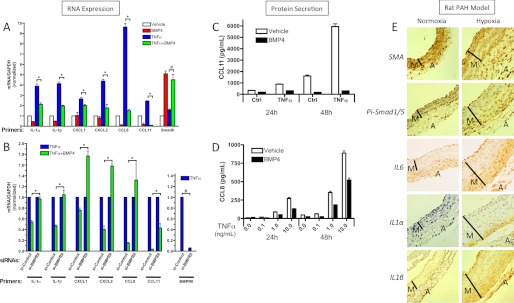FIGURE 1.
The BMP4/BMPR2 pathway is involved in the regulation of inflammation in human PASMCs (hPASMCs) and in a rat PAH model. A, hPASMCs were treated with or without 10 ng/ml TNFα in the presence or absence of 3 nm BMP4 for 24 h, followed by qRT-PCR analysis. Results were normalized to GAPDH expression, and the relative mRNA levels are presented as mean ± S.E., with each experiment conducted in triplicate (n = 3). The difference between two results indicated by asterisks is statistically significant; *, p < 0.05. B, hPASMCs were transfected with 1 nm control siRNA or 1 nm siBMPRII. Twenty-four hours later, cells were stimulated with 3 nm BMP4 or 10 ng/ml TNFα or combined BMP4 (3 nm) and TNFα (10 ng/ml) for 24 h and subjected to qRT-PCR analysis. Results are shown as relative mRNA levels normalized by the value of basal or TNF stimulation without BMP4 treatment. Mean values are expressed ± S.E. C and D, hPASMCs were treated with 3 nm BMP4 or 10 ng/ml TNFα or combined BMP4 (3 nm) and TNFα (10 ng/ml) for 48 h and medium was collected. Protein levels were examined by ELISA assay. The experiment was repeated three times and mean values are expressed ± S.E. E, histological examination of pulmonary arteries (PAs) from rats after 17-day hypoxia or normoxia treatment with anti-SMA, anti-phospho-Smad1/5 (Pi-Smad1/5), anti-IL-6, anti-IL-1α, or anti-IL-1β antibodies (×400) and by hematoxylin staining (×400). The media (M) and adventitia (A) of the PAs are indicated.

